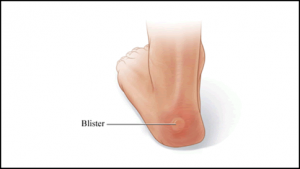 Now that the summer months are upon us, many people are stepping out into sandals and flip-flops. The bearing of feet, however, leaves many wary for the possible existence of blisters on the skin. To handle blisters without creating more damage, there are several tips one can follow: let the blister be, make sure the blister is kept clean, try aloe vera, soak the feet, use proper tools if you decide to pop the blisters, do not remove the loose skin, always use clean bandages, watch for infections, and prevent future blisters.
Now that the summer months are upon us, many people are stepping out into sandals and flip-flops. The bearing of feet, however, leaves many wary for the possible existence of blisters on the skin. To handle blisters without creating more damage, there are several tips one can follow: let the blister be, make sure the blister is kept clean, try aloe vera, soak the feet, use proper tools if you decide to pop the blisters, do not remove the loose skin, always use clean bandages, watch for infections, and prevent future blisters.
Untreated blisters can worsen and make mobility extremely difficult and painful. For quality blister treatment, see Dr. Jeff Wachtel, D.P.M., of Wachtel Family Foot Care. Dr. Wachtel will attend to all of your foot and ankle needs and answer any of your related questions.
Blisters on the Feet
When tight or ill-fitting footwear is worn, many times a foot blister may develop. Blisters can even develop by constant rubbing from the shoe, often times leading to pain.
What is a Foot Blister?
A foot blister is a small pocket that is filled with fluid, forming on the upper most layer of the skin. Blisters are filled with clear fluid, and may lead to drainage of blood or pus if the area has become infected.
How do they Form?
Blisters of the feet are almost always the result of shoe rubbing and constant friction of the skin and material. Long periods of walking in shoes, sandals, or boots which don’t fit properly can result in a blister. Those who often have moisture or humidity in the feet, are prone to blister formation easily.
Prevention & Treatment
Proper care is vital to alleviate pain and prevent infection to the affected area of the foot. The best treatment is to leave them alone. New skin will develop under the blister and during the healing stages, your blister will pop.
If you have any questions, please contact our office located in Lansdale, PA. We offer the newest diagnostic and treatment technologies for all your foot ankle injuries.




